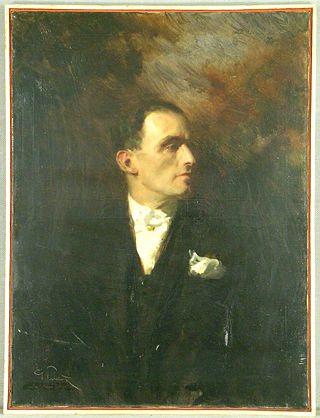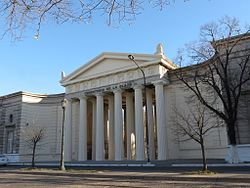
La Recoleta Cemetery is a cemetery located in the Recoleta neighbourhood of Buenos Aires, Argentina. It contains the graves of notable people, including Eva Perón, presidents of Argentina, Nobel Prize winners, the founder of the Argentine Navy, and military commanders such as Julio Argentino Roca. In 2011, the BBC hailed it as one of the world's best cemeteries, and in 2013, CNN listed it among the 10 most beautiful cemeteries in the world.

Buenos Aires is the capital and largest city of Argentina. It is located on the southwest of the Río de la Plata. "Buenos aires" is Spanish for "good airs" or "fair winds". Buenos Aires is classified as an Alpha− global city, according to the Globalization and World Cities Research Network (GaWC) 2024 ranking. The city proper has a population of 3.1 million and its urban area 16.7 million, making it the fourteen largest in the world.

La Plata is the capital city of Buenos Aires province, Argentina. According to the 2022 census, the Partido has a population of 772,618 and its metropolitan area, the Greater La Plata, has 938,287 inhabitants. It is located 9 kilometers inland from the southern shore of the Río de la Plata estuary.

Bernardino de la Trinidad González Rivadavia was the first President of Argentina, then called the United Provinces of the Río de la Plata, from February 8, 1826 to June 27, 1827.

San Luis is a province of Argentina located near the geographical center of the country. Neighboring provinces are, from the north clockwise, La Rioja, Córdoba, La Pampa, Mendoza and San Juan.

Recoleta is a barrio or neighborhood of Buenos Aires, Argentina, located in the northern part of the city, by the Río de la Plata. The area is perhaps best known to be the home of the distinguished Recoleta Cemetery. It is a traditional upper-class and conservative neighborhood with some of the priciest real estate in the city, known for Paris-style townhouses, lavish former palaces and posh boutiques.

The United Provinces of the Río de la Plata, earlier known as the United Provinces of South America, was a name adopted in 1816 by the Congress of Tucumán for the region of South America that declared independence in 1816, with the Sovereign Congress taking place in 1813, during the Argentine War of Independence (1810–1818) that began with the May Revolution in 1810. It originally comprised rebellious territories of the former Spanish Viceroyalty of the Río de la Plata dependencies and had Buenos Aires as its capital.

Federico Lacroze railway station is a passenger railway station in Buenos Aires, Argentina. The station is located in the city's outlying barrio (neighbourhood) of Chacarita in a predominantly residential area. It is just a short distance north of the Cementerio de la Chacarita, the city's largest cemetery. The station is named after Federico Lacroze, a prominent 19th century Argentine railway and transport pioneer who obtained the concession for building the Buenos Aires Central Railway in 1884. When the Argentine railway network was nationalised in 1948 the station became the Buenos Aires terminus for the lines that became part of the General Urquiza Railway (FCGU).

Miguel de Azcuénaga [ˈmi.ɣwel ðe as̻ˈkwe.na.ɣa] was an Argentine brigadier. Educated in Spain, at the University of Seville, Azcuénaga began his military career in the Viceroyalty of the Río de la Plata and became a member of the Primera Junta, the first autonomous government of modern Argentina. He was shortly exiled because of his support to the minister Mariano Moreno, and returned to Buenos Aires when the First Triumvirate replaced the Junta. He held several offices since then, most notably being the first Governor intendant of Buenos Aires after the May Revolution. He died at his country house in 1833.

Mario Palanti was an Italian architect who designed important buildings in the capital cities of both Argentina and Uruguay.
There are many landmarks in Buenos Aires, Argentina, some of which are of considerable historical or artistic interest.

Autovía 2 Juan Manuel Fangio is an Argentine dual carriageway, which runs from Buenos Aires to Mar del Plata. The road was a National Route until 1990 when it was transferred to the Government of Buenos Aires Province. The Autovía 2 extends from the junction of Provincial Routes 1 and 36 and National Route A004, just on the traffic circle "Juan María Gutiérrez", which is the limit of Berazategui and Florencio Varela districts.

The Monument to the Carta Magna and Four Regions of Argentina is located in the intersection of Del Libertador and Sarmiento Avenues, a landmark site in the Palermo, a neighbourhood of Buenos Aires, Argentina. It is commonly referred to as the Monument of the Spanish.
Omar Acha is an Argentine historian and political essayist. He is a researcher at the Consejo Nacional de Investigaciones Científicas y Técnicas and also at the Centro de Investigaciones Filosóficas (Argentina). He teaches Philosophy of History at the Universidad de Buenos Aires. He was also a member of the editorial board of Herramienta. Revista de Teoría y Crítica Marxista, published in Buenos Aires.

Adelina Ethel Dematti de Alaye was an Argentine human rights activist who co-founded the Mothers of the Plaza de Mayo, an organization of mothers whose children disappeared during the Dirty War of the 1970s and early 1980s. She became known as "la madre fotógrafa," or "the mother photographer," for her documentation of the Argentine dictatorship and the Mothers of the Plaza de Mayo through her photography. Her collection was later declared a "Memory of the World" by UNESCO. In addition to her work with the Mothers of the Plaza de Mayo, Dematti was also active within the Permanent Assembly for Human Rights (APDH).
Irina Podgorny is an Argentine anthropologist, a historian of science at the National University of La Plata, permanent staff at CONICET, professor ad honorem and Director of the Archive of History and Photographs at the Natural Science Facility and Museum of the National University of La Plata, and winner of the Bernardo Houssay Young Researcher Award. She has held numerous professorships and scholarships and has worked for CONICET since 2013.
Elbio Raúl Lozza was an Argentine painter, draughtsman, designer, journalist, and theorist who was part of the concrete art movement. He was part of the Asociación Arte Concreto-Invención. He was the founder of the Perceptivist group. He was granted the Platinum Konex Award in Visual Arts from Argentina in 1992.

Susy Shock is an Argentine actress, writer, and singer who defines herself as a "trans sudaca artist".















